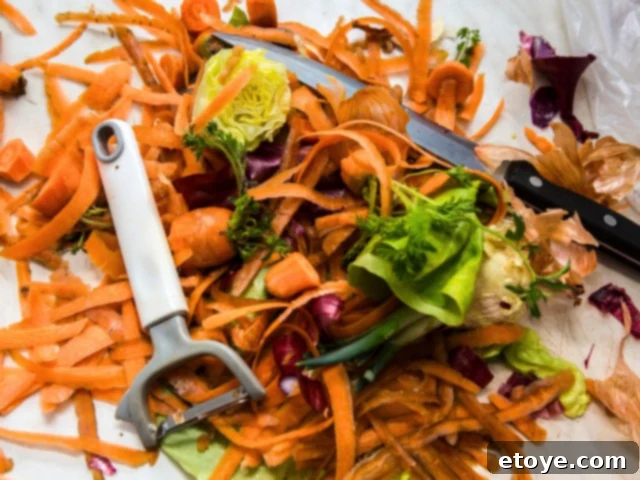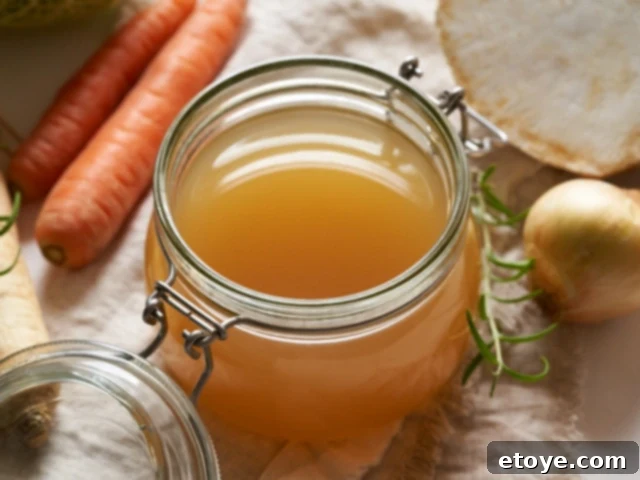Thanksgiving, with its abundance of ingredients and festive feasts, often leaves us with a treasure trove of kitchen scraps. Far from being destined for the bin, these humble remnants—from onion skins and carrot tops to herb stems and garlic peels—hold the key to crafting a culinary masterpiece: homemade vegetable stock. This “liquid gold” is not only a fantastic way to maximize flavor in your cooking but also a powerful tool for minimizing food waste, especially during the holiday season. If you’re looking to transform those overlooked vegetable pieces into a rich, aromatic broth that elevates countless dishes, you’ve arrived at the perfect guide. We’ll delve into the fascinating history of stock-making, provide a simple, effective recipe, and explore a myriad of ways to utilize every delicious drop, helping you cook smarter and more sustainably this Thanksgiving and beyond.

The Ancient Roots of Vegetable Stock: A Journey Through Culinary History
The practice of making stock is deeply embedded in human history, dating back thousands of years to times when resourcefulness was not just a culinary choice but a necessity for survival. Early civilizations understood the immense value in extracting every possible nutrient and flavor from their food, preventing waste long before the concept of modern sustainability emerged. Stock-making was a primal form of cooking, transforming overlooked parts of ingredients into nourishing, flavorful bases for meals.
In ancient China, for instance, bone broths were revered for their purported health benefits and were a staple in the diet. Long, slow simmering of bones with water and various aromatics created deeply flavored liquids that served as the foundation for a multitude of soups and stews, demonstrating an early understanding of flavor extraction and nutrient density. Similarly, medieval European kitchens relied heavily on stocks and broths to create hearty, filling dishes known as “pottage.” These thick, stewed mixtures would simmer all day, incorporating whatever ingredients were available, from root vegetables and grains to any leftover meat scraps. While wealthier households might add exotic spices and choice cuts of meat, peasant families skillfully utilized vegetable trimmings and bones, underscoring the universal practicality of stock-making across different social strata.
The culinary art of stock-making was further refined in 17th-century France. French chefs developed codified recipes for four foundational stocks, or “fonds,” which became indispensable as bases for their classic sauces and elaborate dishes. While many traditional “fonds” were initially meat-based, the concept of vegetable stock gained significant popularity in regions where vegetables were more abundant than meat. Early versions of vegetable stock typically avoided strong-flavored vegetables like bell peppers, green beans, or cruciferous items, which could overpower the delicate balance of the broth. Instead, cooks traditionally focused on a harmonious blend of foundational ingredients to create a balanced and versatile base. The most common and enduring combination, still widely used today in both traditional and plant-based kitchens, includes carrots, onions, celery (often referred to as a “mirepoix”), and the aromatic addition of bay leaf.
This historical journey reveals that making stock from kitchen scraps is not a new trend but a time-honored tradition. What began as a vital means of frugality and resourcefulness has evolved into a beloved culinary hack. Today, chefs and home cooks alike embrace this practice, turning veggie scraps like garlic skins, carrot tops, and mushroom stems into delicious, nutritional stocks that enrich countless meals. It’s a testament to human ingenuity and a delicious way to honor our culinary heritage while promoting food waste reduction in modern kitchens.

Crafting Your Own Liquid Gold: A Simple Guide to Homemade Vegetable Stock
Making your own homemade vegetable stock is remarkably straightforward, requiring minimal effort and maximizing the use of ingredients you might otherwise discard. The beauty of this process lies in its flexibility—you can use virtually any suitable vegetable scraps you have on hand, transforming them into a rich, aromatic base for your cooking. This guide will walk you through the simple steps to create a deeply flavorful broth that will become a staple in your kitchen.
Step-by-Step Instructions:
- Collect Your Scraps: The first step is to consistently collect your vegetable scraps. Keep a large freezer-safe bag or container handy in your freezer. Populate it with items like onion skins, the root ends of onions, carrot tops, celery ends, broccoli stems, kale stems, mushroom stems, garlic skins, leek greens, and even parsley or cilantro stems. Avoid scraps from strong-flavored or cruciferous vegetables such as cabbage, Brussels sprouts, or cauliflower, as they can impart an undesirable bitter or sulfurous taste to your stock.
- Prepare for Simmering: Once you’ve accumulated a good quantity of scraps (aim for at least 4-6 cups for a standard pot), transfer them from the freezer to a large stock pot or Dutch oven.
- Add Water and Aromatics: Cover the vegetable scraps with cold water, ensuring there’s about an inch of water above the vegetables. Cold water is key as it allows for a gradual extraction of flavors. Now, enhance your stock with aromatics. Add 1-2 bay leaves, a generous pinch of salt (you can adjust more later), and 5-6 whole black peppercorns. If you have them, fresh herb stems (like parsley or thyme) or a few sprigs of rosemary can add wonderful depth.
- Bring to a Boil, Then Simmer: Place the pot over high heat and bring it to a rolling boil. As soon as it boils, reduce the heat to a gentle simmer. The surface of the liquid should barely ripple. Cover the pot partially to allow some steam to escape but retain most of the aroma.
- Simmer for Flavor Extraction: Let your stock simmer gently for a minimum of 45 minutes to an hour. For a more intense flavor, you can extend the simmering time to 1.5 to 2 hours. However, avoid simmering for much longer than 2 hours, as vegetable stock can sometimes develop an overly concentrated or even slightly bitter taste if cooked for too long.
- Strain and Cool: Once the simmering is complete and you’re satisfied with the aroma and flavor, remove the pot from the heat. Carefully strain the stock through a fine mesh strainer into a clean bowl or container. Press down on the solids in the strainer with the back of a spoon to extract every last drop of that precious, flavorful liquid. Discard the spent vegetable scraps (or better yet, add them to your compost pile!).
- Store Your Stock: Allow the veg stock to cool completely before storing it. Once cooled, transfer it to airtight containers. It can be refrigerated for up to 5-7 days or frozen for up to 6 months. For convenient single portions, freeze the stock in ice cube trays, then transfer the frozen cubes to a freezer bag.
Congratulations! You’ve just made a delicious, nutritious, and incredibly versatile homemade broth that’s ready to elevate your cooking, minimize waste, and add a layer of rich flavor to countless dishes.

Unlock Culinary Creativity: Versatile Uses for Your Homemade Vegetable Stock
Once you’ve mastered the art of making flavorful vegetable stock, a world of culinary possibilities opens up. This humble liquid gold, born from everyday kitchen scraps, is an indispensable ingredient that can elevate the taste and nutritional value of countless dishes. Here are just some of the incredible ways you can put your homemade veggie stock to work, transforming ordinary meals into extraordinary culinary experiences.
Freeze It For Future Flavor
One of the best strategies for managing your bounty of homemade vegetable broth is to freeze it for later use. Pour your cooled stock into ice cube trays, freeze until solid, then pop these handy cubes into a large freezer bag. These concentrated cubes of flavor are perfect for adding a quick boost to grain bowls, pan sauces, stir-fries, or whenever you need a small amount of liquid. You can also freeze larger portions in airtight containers or mason jars (leaving headspace for expansion). Freezing stock is not only a fantastic way to preserve the rich nutritional value of your veggies but also a smart strategy to significantly reduce food waste, ensuring every bit of your leftover vegetable scraps serves a delicious purpose.
Use It As Your Primary Cooking Liquid
Why settle for plain water when you can infuse your dishes with incredible depth of flavor? If your Thanksgiving menu includes sides like green beans, sweet potatoes, or garbanzo beans, consider cooking them in veggie broth instead of water. This simple trick works wonders for any type of grain as well; swap water for your own vegetable broth when cooking rice, quinoa, farro, couscous, or bulgur. Not only does this add a profound layer of savory richness to the dish, but it also provides a good use for your stock while it’s fresh. Once you experience the difference, you’ll find it hard to go back to cooking grains with just water.
The Perfect Base for Homemade Soups and Stews
A truly killer soup or stew starts with an exceptional base, and homemade vegetable stock is the perfect way to achieve this. Whether you’re whipping up a hearty chunky vegetable soup, a creamy pureed bisque, or a comforting lentil stew, your homemade stock provides a depth of savory flavors that store-bought broths often can’t match. For an even more robust flavor profile, don’t hesitate to toss in a few extra herb stems, a couple of garlic skins, or even the root end of an onion directly into your soup pot as it simmers, enhancing the broth’s complexity.
Elevate Vegetarian and Vegan Dishes
For those serving plant-based eaters, homemade broth is an invaluable ingredient. It brings an unparalleled depth of flavor to vegetarian recipes like creamy mushroom risotto, hearty lentil stews, flavorful curries, or a classic Thanksgiving stuffing. Substituting plain water with your rich vegetable stock ensures these dishes are bursting with umami and savory notes, providing a satisfying experience that highlights the natural flavors of the vegetables. It’s a testament to the fact that plant-based cooking can be incredibly rich and complex, all thanks to a simple, flavorful base made from your saved veggie scraps.
Enhance Sautéed Vegetables and Deglaze Pans
When sautéing vegetables like Brussels sprouts, bell peppers, or broccoli stems, a splash of veggie stock can work wonders. Use it to deglaze the pan, releasing all those flavorful browned bits stuck to the bottom, which adds an incredible depth of flavor to your dish. This technique also helps prevent vegetables from sticking without requiring excessive olive oil, keeping them moist and tender. A small amount of stock introduces a lovely umami punch, making your everyday sautéed greens or stir-fries taste remarkably better.
Reinvent Risottos and Grain Bowls
Your homemade vegetable stock is the secret weapon for creating luscious risottos and vibrant grain bowls. For risottos, the slow addition of warm stock is crucial for developing that signature creamy texture and infusing every grain of rice with deep flavor. Similarly, if you have leftover cooked grains like rice, barley, or quinoa in the fridge, heat them gently in a bit of vegetable stock to revitalize them and add a fresh burst of flavor. Stir in some finely chopped onion peels or green onion for an extra boost. The versatility of your stock pot extends far beyond just soup; it’s the foundation for creating sophisticated and satisfying grain-based meals. A final sprinkle of parmesan cheese can add an extra savory dimension.
Compost Any Remaining Scraps and Embrace Zero Waste
Even after you’ve extracted every last bit of delicious flavor from your vegetable scraps to make your stock, their journey doesn’t have to end. The spent solids are perfect for your compost pile or compost bin. This completes a beautiful cycle of sustainability: you’ve transformed leftover vegetable scraps into a flavorful vegetable stock for your kitchen, and then returned the organic matter to the earth to enrich your garden. It’s a powerful step towards a zero-waste kitchen and a fantastic way to give back to your garden, especially after a busy Thanksgiving of cooking. Rethinking food waste after the holidays has never been so rewarding.

Pro Tips for Crafting the Ultimate Vegetable Stock
While making vegetable stock is inherently simple, a few expert tips can elevate your homemade broth from good to truly exceptional. These insights will help you maximize flavor, ensure clarity, and avoid common pitfalls, making your stock a more versatile and delicious foundation for all your culinary endeavors.
- Embrace a Fine Mesh Strainer: To achieve a perfectly clear and smooth broth, always strain your stock through a fine mesh strainer. For an even more refined result, line the strainer with cheesecloth. This meticulous straining process removes all the tiny bits of vegetable matter, ensuring a pristine liquid that won’t cloud your finished dishes.
- Select Your Scraps Wisely: As mentioned, avoid cruciferous vegetables like cabbage, cauliflower, Brussels sprouts, or even large amounts of broccoli stems. These can impart a distinct, sometimes bitter taste or a strong, sulfurous aroma that may overpower the delicate flavors of your stock. Stick to milder vegetables for a versatile base.
- Don’t Forget the Aromatics: Bay leaves, a pinch of salt, and black peppercorns are your best friends in stock making. They are essential for building foundational flavor. You can also add a sprig of fresh thyme or parsley stems for an herbaceous note.
- Roast for Deeper Flavor: For an extra layer of richness and a beautiful golden color, consider roasting your vegetable scraps (especially onion, carrot, and celery pieces) in the oven before adding them to your pot. A light char on some of the vegetables can add a wonderful depth and sweetness to the finished stock.
- Mind the Simmer Time: While longer simmering can be beneficial for meat stocks, vegetable stock is best simmered for 45 minutes to 2 hours. Over-simmering can sometimes extract too much chlorophyll from greens, leading to a greener color and a potentially bitter flavor.
- Season Gradually: Add salt sparingly at the beginning. As the stock reduces during simmering, the salt will concentrate. It’s always easier to add more salt later than to try and fix an overly salty stock. Taste and adjust seasoning at the very end.
- Cool Quickly and Store Safely: Once strained, cool your stock as quickly as possible to prevent bacterial growth. Divide it into smaller containers, or place the pot in an ice bath. Once cool, transfer to airtight containers and refrigerate or freeze promptly.

Let’s Get to Stockin’ and Savoring!
This Thanksgiving, transform your kitchen scraps into a secret weapon of flavor. By embracing the age-old practice of making homemade vegetable stock, you’re not just cooking; you’re engaging in a delightful act of culinary resourcefulness and sustainability. This liquid gold empowers you to infuse depth and character into every dish, proving that true flavor often comes from the most humble of beginnings.
Imagine the possibilities: from a comforting bowl of soup on a chilly evening to a perfectly creamy risotto, a rich pan sauce for roasted vegetables, or simply a more flavorful base for your grains. There’s truly no end to the creative applications for your leftover vegetable stock. Beyond the delicious results, there’s immense satisfaction in knowing you’ve minimized food waste and extracted every bit of potential from your Thanksgiving prep. So, gather those scraps, simmer with intention, and prepare to elevate your everyday cooking to something truly extraordinary. Your taste buds, and the planet, will thank you.
How will you use your homemade veggie stock? We’d love to hear your creative ideas! Leave us a comment below and share your favorite ways to enjoy this versatile kitchen staple.
Want More Ways to Love Your Leftovers?
- No Waste November: A 7-Day Meal Plan for Thanksgiving Leftovers
- Meal Ideas For Turkey Day Leftovers
- What To Do With Thanksgiving Leftovers: Turn THIS into THAT
- Leftover Turkey: “The Bobbie” Thanksgiving Sandwich
